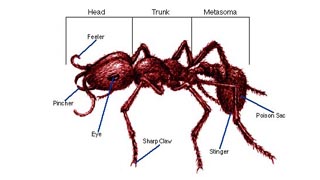News About Ants
Ants are eusocial insects of the family Formicidae and, along with the related families of wasps and bees, belong to the order Hymenoptera. They are a diverse group of more than 12,000 species, with a higher diversity in the tropics. They are known for their highly organized colonies and nests, which sometimes consist of millions of individuals. Individuals are divided into sub-fertile, and more commonly sterile, females ("workers", "soldiers", and other castes), fertile males ("drones"), and fertile females ("queens"). Colonies can occupy and use a wide area of land to support themselves. Ant colonies are sometimes described as superorganisms because the colony appears to operate as a unified entity.
Ants have colonized almost every landmass on Earth. The only places lacking indigenous ant species are Antarctica, Greenland, Iceland, parts of Polynesia, the Hawaiian Islands, and other remote or inhospitable islands.[1][2] When all their individual contributions are added up, they may constitute up to 15 to 25% of the total terrestrial animal biomass.[3]
Termites, sometimes called white ants, are not closely related to ants, although they have similar social structures.

